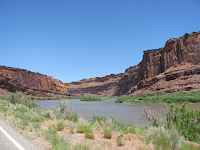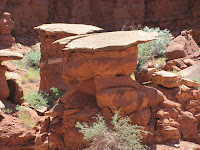*Birds we’ve seen on our 2010 trip so far: white-wing dove, ravens, Gamble’s quail, western tanager, roadrunner, violet-green swallow, California condor, great blue heron, mountain bluebird, wild turkey, black-chinned hummingbird, juniper titmouse
*National Parks/Monuments visited on 2010 trip so far: 16
*State Parks visited on 2010 trip so far: 4
*Total number of Jr. Ranger badges so far: 15
[Click on any picture to enlarge…then arrow back to the blog]
One of the coolest places we wanted to revisit this year was Goblin Valley State Park (http://www.utah.com/stateparks/goblin_valley.htm). Last year we visited in Aug. and we were about the only ones there. However, in June this year the campground was near
The park has a great visitor center with lots of informative exhibits. In fact, it’s one of the best we’ve seen, and while there, we earned another Junior Ranger badge. We also attended an evenin
During our stay we made side trips to Canyonlands National Park (http://www.nps.gov/cany) and Arches National Park ((http://www.nps.gov/arch), both of which we had visited last year (July2009ArchesCanyonlands). Both are so amazing and so different. Russ commented if you had never been to the Grand Canyon, and someone brought you to Canyonlands and told you it was the
Our main goal this time was to walk the Upheaval Dome Overlook Trail, a one mile round trip hike with an elevation gain of about 200 feet. Upheaval Dome measures 1 mile in diameter and looks like a large volcanic crater with peaks jutting from the center. It’s a mystery as to how it was created, and even scientists can’t agree on whether it was caused by a meteor impact or as a result of a salt dome. They are two extremely different theories that you’d think could be proven one way or the other. While up there, Russ even “discover ed” a little arch (he's pointing to it below left).
ed” a little arch (he's pointing to it below left).
At Arches NP, we did little hiking as it was very hot. However we did get out at the Double Arch and walked about halfway down the trail. Double Arch actually has three major openings that began as one pothole arch and are still continuing to slowly enlarge. We also stopped at Delicate Arch, a free-standing sandstone formation that stands 45 feet high and 33 feet wide. The hike to the arch is 3 miles and considered strenuous, so we opted out of it again this year, but I was able to get a much better picture of it from the beginning of the trail. (Russ bought me a new camera for my birthday in March that has a 10x optical zoom.) And for all you Star Wars fans, we spotted Jabba the Hut nearby!
We took a drive one day along State Road 128, a scenic byway that takes you through the Colorado Riverway Recreation Area that cuts through the red rock gorge of the Colorado River. On the river below, we could see quite a number of rafters floating along the waterway. With the temperature over 100, it seems these people might have had the right idea!

Another day we loaded the dogs into the car driving into the nearby town of Moab, and then turned onto State Road 279, another Utah scenic byway following the Colorado River. Locally it is also known as “Potash Road” as it ends at a potash mine. Along the way we stopped at the Poison Spider Mesa Trail pullout to view mor e petroglyphs and some dinosaur footprints that are located high up on a rock slab and have been painted white for easier viewing. (We chose not to hike the trail up there since we had the dogs.)
e petroglyphs and some dinosaur footprints that are located high up on a rock slab and have been painted white for easier viewing. (We chose not to hike the trail up there since we had the dogs.)
A bit
further down the road, we spotted a sign for the Jug Handle Arch so we turned right onto the dirt road to check it out. Traveling very slowly along this rocky road, we found ourselves among the cliffs at the bottom of a canyon. About 5 miles in, we p ulled over, and Russ stopped an oncoming car to ask how much further and if it was worth the trip. The guy indicated that it was still quite a ways and there were some deep ruts so he wasn’t sure we could make it without 4-wheel drive. He also said it was basically a huge rock that had fallen across the road but the scenery was be
ulled over, and Russ stopped an oncoming car to ask how much further and if it was worth the trip. The guy indicated that it was still quite a ways and there were some deep ruts so he wasn’t sure we could make it without 4-wheel drive. He also said it was basically a huge rock that had fallen across the road but the scenery was be autiful. This seemed odd since we’ve learned during our travels that an arch is naturally formed from a hole in the rock and created through erosion. We let the dogs out to stretch their legs, and since there was hardly any traffic, Abby had a blast running up and down the road. Since we didn’t want to chance getting stuck, we turned around figuring it just wasn’t meant to be
autiful. This seemed odd since we’ve learned during our travels that an arch is naturally formed from a hole in the rock and created through erosion. We let the dogs out to stretch their legs, and since there was hardly any traffic, Abby had a blast running up and down the road. Since we didn’t want to chance getting stuck, we turned around figuring it just wasn’t meant to be that we see the arch. Right before we were back at SR 279, guess what we saw at the intersection several hundred feet above the road? Yep, you guessed it…the Jug Handle Arch, measuring 46 feet high and only 3 feet wide. It had been right there where we first turned, but once again we had seen some amazing scenery off the beaten path.
that we see the arch. Right before we were back at SR 279, guess what we saw at the intersection several hundred feet above the road? Yep, you guessed it…the Jug Handle Arch, measuring 46 feet high and only 3 feet wide. It had been right there where we first turned, but once again we had seen some amazing scenery off the beaten path.

1 comment:
I knew it... I had a feeling... somewhere in your travels... an alien would surface sooner or later. So ... E.T. didn't go home! Have fun. Richard
Post a Comment